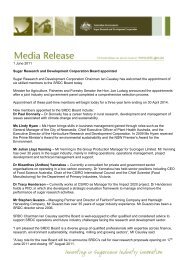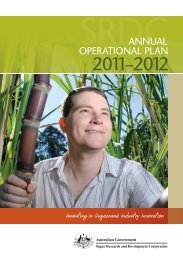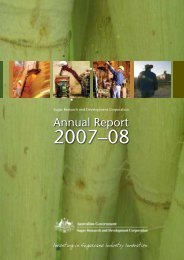Section 2 - Sugar Research and Development Corporation
Section 2 - Sugar Research and Development Corporation
Section 2 - Sugar Research and Development Corporation
You also want an ePaper? Increase the reach of your titles
YUMPU automatically turns print PDFs into web optimized ePapers that Google loves.
<strong>Section</strong> 3<br />
RESEARCH PROJECT SUMMARIES<br />
The section below summarises the projects completed in 2010–2011. Some<br />
projects have been excluded due to their commercial-in-confi dence status.<br />
Regional futures<br />
Key<br />
Performance<br />
Indicator<br />
Enhanced structure <strong>and</strong> functions<br />
of regional sugarcane industry<br />
value chains<br />
Measure Demonstration of improved<br />
integration of the industry value<br />
chain within regions delivering<br />
increased profi tability <strong>and</strong> more<br />
effi cient use of capital based on<br />
environmentally responsible <strong>and</strong><br />
safe business practices.<br />
Harvest planning management tools<br />
The Tully <strong>Sugar</strong> Limited milling district has large<br />
geographical, varietal, <strong>and</strong> seasonal differences<br />
in sugar yield. Growers were looking to increase<br />
profi tability by capitalising on these differences,<br />
but had to consider variety, crop class, crop age,<br />
CCS, cane yield, <strong>and</strong> soil type simultaneously when<br />
planning the harvest. Adding to the complexity is<br />
the infl uence of large harvesting groups, high mill<br />
crushing rates, <strong>and</strong> a wet tropical environment.<br />
‘Harvest Plan’, developed by the growers in the<br />
SRDC funded ‘Working Together for Our Future’<br />
Action Group, indicated key drivers for growers<br />
planning a harvest schedule.<br />
Typically, growers vary this plan to take into<br />
account the weather <strong>and</strong> transport logistics.<br />
This complex decision making process can<br />
be simplifi ed if growers are able to produce<br />
a number of management scenarios using<br />
decision support tools.<br />
This project reviewed all the harvest planning<br />
decision support tools available <strong>and</strong> revealed that<br />
there were no ‘off the shelf’ solutions available.<br />
However, it did fi nd that the CSIRO <strong>Sugar</strong>Max<br />
models could be adapted for use in harvest<br />
planning for the Tully district. The <strong>Sugar</strong>Max<br />
tool was developed by previous SRDC projects<br />
to provide increased capacity for growers to<br />
learn from <strong>and</strong> adopt improved time-of-harvest<br />
schedules (CGT001).<br />
Increasing in-mill Near Infra Red (NIR)<br />
effectiveness <strong>and</strong> communicating data<br />
Advancement in precision agriculture (PA)<br />
techniques offered an opportunity to improve<br />
the productivity, profi tability <strong>and</strong> environmental<br />
performance of the growing <strong>and</strong> harvesting<br />
sector through the use of NIR generated data<br />
to measure nutrient levels in prepared cane.<br />
Field trials on two sites in the Burdekin region<br />
<strong>and</strong> two sites in the Mackay region were soil<br />
tested before varying rates of nutrients were<br />
applied to each strip. Results of leaf tests were<br />
used to establish any relationship between<br />
in-fi eld management practices <strong>and</strong> the NIR<br />
cane analysis after harvesting. A customised<br />
Geographic Information System (GIS) application<br />
established the link between analysis results<br />
<strong>and</strong> the cane source. However, the trials failed<br />
to establish a defi nitive link between in-fi eld<br />
nutrient practices <strong>and</strong> NIR results.<br />
The legacy of this project is the improved ability<br />
to analyse data at a more refi ned spatial level<br />
than previously possible. With this new level<br />
of in-fi eld data recording, at least one new<br />
project has been established that will analyse<br />
the relationship between NIR derived nutrient<br />
data <strong>and</strong> in fi eld management practices with<br />
particular emphasis on mill mud application<br />
rates (CSR038).<br />
SRDC Annual Report 2010–2011 51






